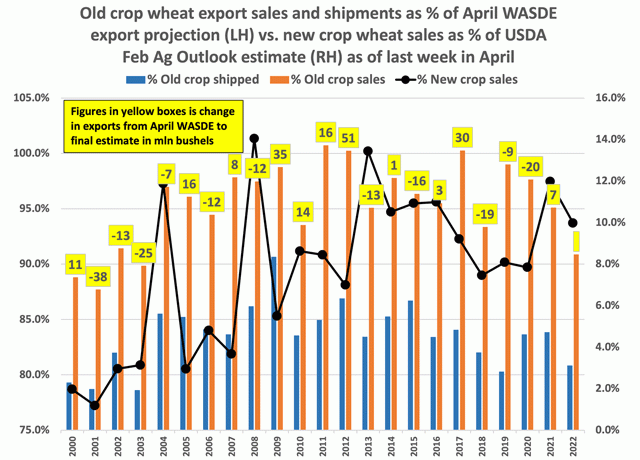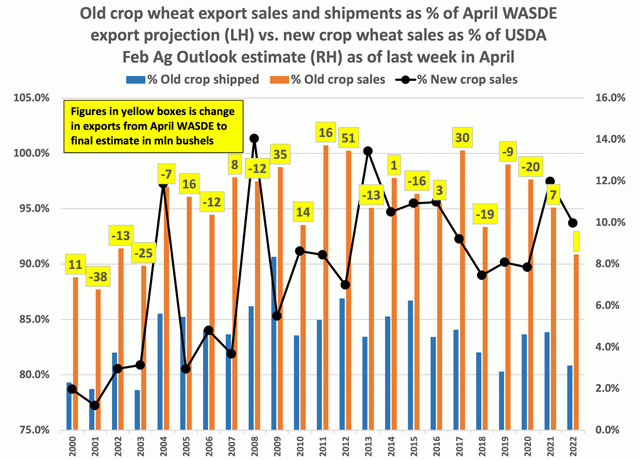Fundamentally Speaking
Old-Crop vs New-Crop Wheat Sales, Shipments
Not much negative you can say about a wheat market when you have the Kansas City and Minneapolis futures at new contract highs and their second loftiest levels ever and Chicago not that far behind. After a couple of laggard weeks this market has sprung to life as the big news this past week was India phasing back its wheat exports due to a devastating heatwave in that country over the past six to eight weeks that has cut this year's crop output as the Indian government, like many others around the world, looks to conserve supplies for domestic needs in order to curb record high food inflation. But this leaves world wheat importers scrambling.
Wheat is also being supported by serious delays in getting the hard red spring and durum wheat crops seeded in the Northern Plains as forecasts indicate continued unneeded moisture and well below average temperatures.
Meanwhile, despite some desperately needed rains in the parched areas of the Central and Southern Plains, it may be a case of too little, too late. It appears so far rains forecasted for western Kansas and the Oklahoma and Texas Panhandles have been a bust.
P[L1] D[0x0] M[300x250] OOP[F] ADUNIT[] T[]
We are also starting to see more comment about the Argentine wheat crop needing more rain. In addition, limited wheat exports out of Russia and Ukraine that have 30% of the overseas market are not helping too much.
Perhaps the only bearish price driver is U.S. not seeing much overseas business as for sixth time in a row USDA ia likely to pare our 2021/22 wheat exports in the May 12 WASDE report.
This graph shows old-crop wheat export sales and shipments as a percent of the April WASDE export projection on the left hand axis and new-crop sales for the marketing year starting June 1 as a percent of the USDA's February Ag Outlook Forum export projection on the right hand axis, both as of the last week in April.
The latest weekly export sales and shipment figures showed that at the end of last month, total wheat sold for the 2021/22 season was 713.4 million bushels (mb) and of that 634.7 mb was shipped; that is 90.8% and 80.8% of the April 2022 WASDE export projection of 785 mb, respectively. This is the lowest percent sold since the 2002/03 season while the amount shipped as a percent of the April WASDE is the second lowest also going back to that 2002/03 marketing year.
The numbers in the yellow boxes are the change in exports from April WASDE to final figure in million bushels. These figures show similar years, when the amount of wheat sold and shipped was this low with just one month left in the marketing year, strongly suggest another cut in this year's exports, probably close to 25 mb.
Meanwhile, even though USDA will also release its first official projection of the 2022/23 U.S. wheat exports in the upcoming WASDE report, the amount of next year's wheat on the books at 84.8 mb is 10% of the USDA's 2022 February Ag Outlook Forum export projection of 850 mb which is not too bad.
Interestingly, over the past 20 years the difference between the USDA's Ag Outlook Forum export projection and the initial estimate in the May WASDE report has averaged only around 5 mb and usually just plus or minus 50 million bushels though did see a jump of 175 million in the 2012/13 year and 100 mb reductions in the 2011/12 and 2014/15 seasons.
Interestingly over the past 20 years, the difference between the USDA's Ag Outlook Forum export projection and the initial estimate in the May WASDE report is only around 5 mb and usually just plus or minus 50 mb, though did see a jump of 175 mb in the 2012/13 year and 100 mb reductions in the 2011/12 and 2014/15 seasons.
(c) Copyright 2022 DTN, LLC. All rights reserved.





Comments
To comment, please Log In or Join our Community .